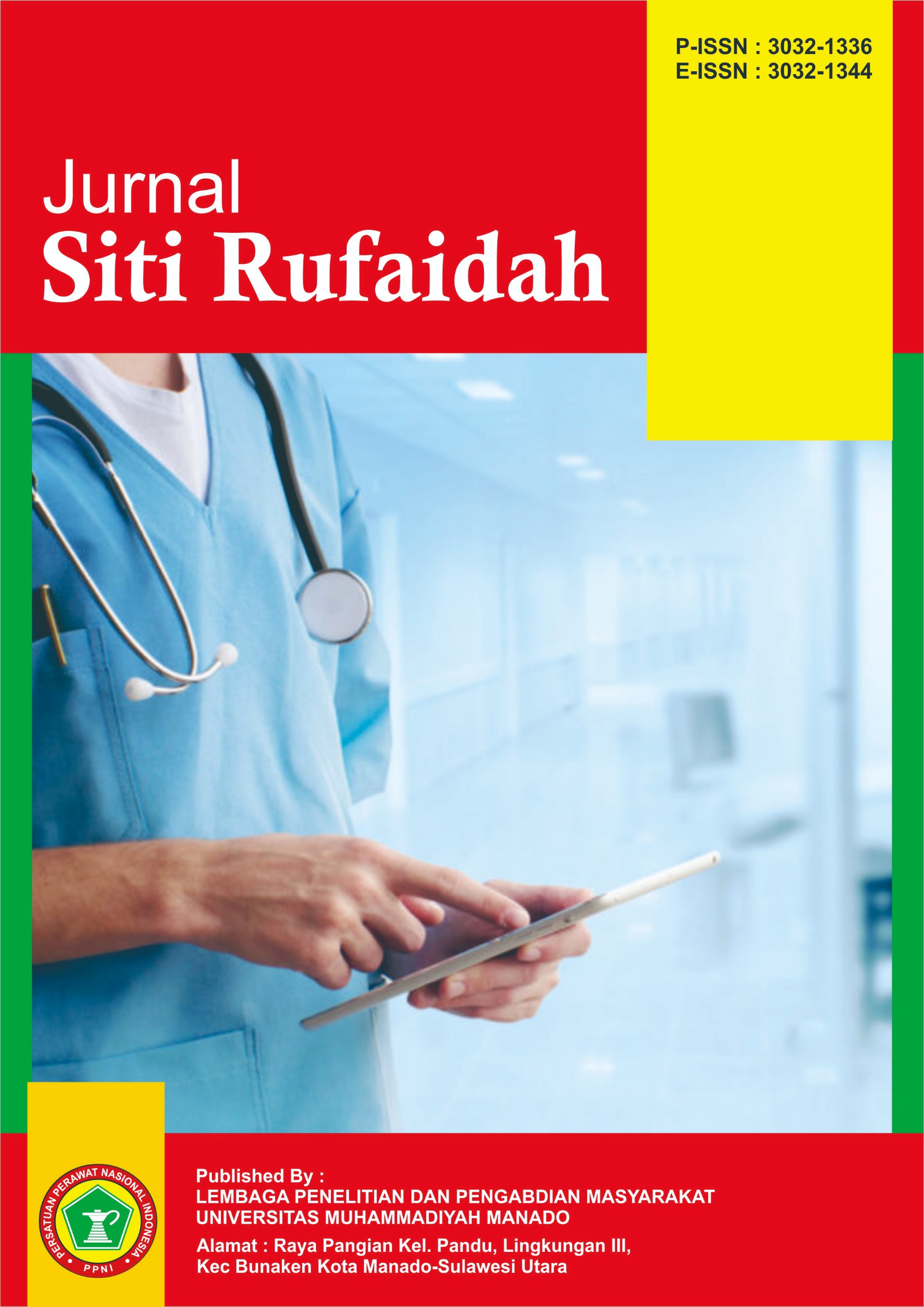Hubungan Tingkat Keparahan dan Tingkat Kontrol dengan Kualitas Hidup Pasien Asma Bronkial di Poli Paru RSUD dr. H. Moch. Ansari Saleh Banjarmasin
DOI:
https://doi.org/10.57214/jasira.v3i3.218Keywords:
bronchial asthma, control level, Mini-AQLQ, quality of life, severityAbstract
Bronchial asthma is a chronic respiratory disease that significantly impacts the quality of life of sufferers. The severity and level of asthma control are important factors in determining a patient's condition. Data from the Pulmonary Clinic of Dr. H. Moch. Ansari Saleh Regional General Hospital (RSUD) show an increase in the number of asthma patients every year, necessitating further analysis of the factors that influence the quality of life of sufferers. This study aims to analyze the relationship between severity and control levels and the quality of life of bronchial asthma patients. This study used an observational analytical design with a cross-sectional approach. The study sample consisted of 47 respondents selected using a purposive sampling method according to the inclusion criteria. The instruments used included a severity questionnaire based on the Global Initiative for Asthma (GINA) guidelines, the Asthma Control Test (ACT), and the Mini Asthma Quality of Life Questionnaire (Mini-AQLQ). Data analysis was performed using the Kendall's Tau-b test with a significance level of 0.05. The results showed that the majority of respondents were female (53.2%) and aged 31–45 years (36.2%). The highest asthma severity was mild persistent (29.8%), while the most dominant level of control was fully controlled (38.3%). The quality of life of the respondents was mostly in the moderate category (38.3%). Statistical tests showed a significant relationship between severity and quality of life (p = 0.003) and between control and quality of life (p = 0.001). It can be concluded that the higher the level of asthma severity, the lower the patient's quality of life tends to be, while better asthma control is associated with a better quality of life. These results emphasize the importance of early detection, optimal asthma control, and regular monitoring by healthcare professionals to improve patients' quality of life.
References
Amal. (2022). Tingkat keparahan dan tingkat kontrol terhadap kualitas hidup pasien asma bronkial. Dinamika Kesehatan Jurnal Kebidanan dan Keperawatan, 3(1), 53–61.
CADTH. (2019). Service line: CADTH common drug review version: Final (with redactions) CADTH common drug review clinical review report Fluticasone propionate (Aermony Respiclick) (Teva Canada Innovation).
Calista. (2024). Pengaruh tingkat kecemasan dan depresi terhadap kualitas hidup penderita asma di kalangan dewasa. Jurnal Sosiohumaniora Nusantara, 2(1), 86–94.
Fatima Marsidi, C., Wiyono, I., & Jayanti, M. (2023). Hubungan tingkat kontrol asma dengan kualitas hidup pasien asma bronkial di Klinik Interna RSUD Kotamobagu. Jurnal Kesehatan Tambusai, 4(2), 579–586.
Hayes, D., Morales, D. L. S., Abston, E., Adamson, G. T., Berger, J. T., Cohen, S. P., … Qureshi, A. M. (2025). Interventional strategies for children with progressive pulmonary hypertension despite optimal therapy: An official American Thoracic Society clinical practice guideline. American Journal of Respiratory and Critical Care Medicine, 211(2), 157–173. https://doi.org/10.1164/rccm.202410-1901st
Helen Okti Marantika, & Indriyani, N. F. (2022). Hubungan tingkat kontrol asma dengan kualitas hidup mahasiswa Fakultas Kedokteran Universitas Muhammadiyah Palembang. Artikel Penelitian, 3(1), 23–27.
Hendryadi. (2019). Metode penelitian: Pedoman penelitian bisnis dan akademik. Lembaga Pengembangan Manajemen dan Publikasi Imperium (LPMP Imperium).
Ikawati, Z. (2011). Farmakoterapi penyakit sistem pernafasan. Pustaka Adipura.
Kowalak. (2011). Buku ajar patofisiologi. EGC.
Kurniawan, C., & Putri, A. L. (2024). Efek edukasi terhadap quality of life pada pasien asma: Tinjauan sistematis. Jurnal Keperawatan, 16(4), 217–226.
Latiza, S., & Hartono. (2024). Asma bronkial persisten ringan serangan berat well-controlled dengan obat pengendali pada anak usia 6 tahun. Jurnal Ners, 8, 1726–1731.
Lorenzia. (2023). Studi efektivitas biaya terkait pemilihan obat asma bronkial rawat inap di suatu rumah sakit swasta di Surabaya. Ilmiah Sains dan Teknologi, 3(2), 21–33.
NHLBI. (2007). National Heart, Lung, and Blood Institute National Asthma Education and Prevention Program Expert Panel Report 3: Guidelines for the Diagnosis and Management of Asthma Full Report 2007.
Oemiati, R. (2010). Faktor-faktor yang berhubungan dengan penyakit asma di Indonesia. Media Litbang Kesehatan.
Perhimpunan Dokter Paru Indonesia (PDPI). (n.d.). [Judul tidak tersedia].
Reddel, H. K., Bacharier, L. B., Bateman, E. D., Brightling, C. E., Brusselle, G. G., Buhl, R., … Boulet, L. P. (2022). Global Initiative for Asthma Strategy 2021: Executive summary and rationale for key changes. European Respiratory Journal, 59(1). https://doi.org/10.1183/13993003.02730-2021
Rengganis, I. (2008). Diagnosis dan tatalaksana asma bronkial. Majalah Kedokteran Indonesia.
Saragih, I. S., Gaol, H. L., Ginting, A. A. Y., Sembiring, F., Saragih, H., & Simbolon, M. P. A. (2024). Implementasi senam asma pada lansia di UPT Pelayanan Sosial Lanjut Usia Binjai. Jurnal Kreativitas Pengabdian Kepada Masyarakat (PKM), 7(2), 806–812. https://doi.org/10.33024/jkpm.v7i2.13083
Siregar, S. P. (2000). Faktor atopi dan asma bronkial pada anak. Sari Pediatri.
Sugiyono. (2017). Metode penelitian kuantitatif, kualitatif, dan R&D. CV Alfabeta.
Sugiyono. (2019). Metode penelitian kuantitatif, kualitatif, dan R&D. Alfabeta.
Sutrisna, M., & Hanifah. (2022). Pendidikan kesehatan tentang peningkatan kualitas hidup pasien asma bronkial. Community Development Journal, 3(3), 2242–2245.
Untari, E. K., Yuswar, M. A., & Rizkifani, S. (2024). Telaah kualitas hidup pasien penyakit kronik di Kalimantan Barat. Jurnal Epidemiologi Kesehatan Komunitas, 9(2), 183–191.
Downloads
Published
How to Cite
Issue
Section
License
Copyright (c) 2025 Jurnal Siti Rufaidah

This work is licensed under a Creative Commons Attribution-ShareAlike 4.0 International License.






